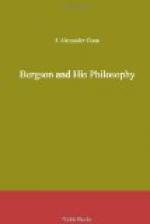Having asserted the falsity of the view of Time ordinarily held, Bergson proceeds to make clear to us his view of what Real Time is—an undertaking by no means easy for him, endeavouring to lay before us the subtleties of this problem, nor for us who endeavour to interpret his language and grasp his meaning. We are indeed here face to face with what is one of the most difficult sections of his philosophy. An initial difficulty meets us in giving a definite name to the Time which Bergson regards as so real, as opposed to the spatial falsity, masquerading as Time, whose true colours he has revealed. In the original French text Bergson employs the term duree to convey his meaning. But for the translation of this into English there is no term which will suffice and which will adequately convey to the reader, without further exposition, the wealth of meaning intended to be conveyed. “Duration” is usually employed by translators as the nearest approach possible in English. The inadequacy of language is never more keenly felt than in dealing with fundamental problems of thought. Its chief mischief is its all-too-frequent ambiguity. In the following remarks the original French term la duree will be used in preference to the English word “Duration.”
The distinction between the false Time and true Time may be regarded as a distinction between mathematical Time and living Time, or between abstract and concrete Time. This living, concrete Time is that true Time of which Bergson endeavours to give us a conception as la duree. He has criticized the abstract mathematical Time, his attack having been made to open up the way for a treatment of what he really considers Time to be. Now, from the arguments previously mentioned, it follows that Time, Real Time, which is radically different from space, cannot be any homogeneous medium. It is heterogeneous in character. We are aware of it in relation to ourselves, for it has reference not to the existence of a multiplicity of material objects in space, but to a multiplicity of a quite different nature, entirely non-spatial, viz., that of conscious states. Being non-spatial, such a multiplicity cannot be composed of elements which are external to one another as are the objects existing in space. States of consciousness are not in any way external to one another. Indeed, they interpenetrate to such a degree that even the use of the word “state” is apt to be misleading. As we saw in the chapter on The Reality of Change, there can be strictly no states of consciousness, for consciousness is not static but dynamic. Language and conventional figures of speech, of which the word “state” itself is a good example, serve to cut up consciousness artificially, but, in reality, it is, as William James termed it, “a stream” and herein lies the essence of Bergson’s duree—the Real as opposed to the False Time. “Pure Duration” (la duree pure), he says, “is the form which the succession of our conscious states




